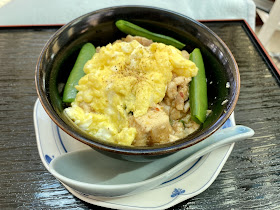*Digression alert: Sansho 山椒 or Japanese pepper is from a shrub closely related to but different from the Sichuan pepper plant. Japanese use the young leaves from this plant as a garnish/herb called “kinome” 木の芽 which has a very nice almost citrusy smell. The unripe fruit is used in many Japanese simmered dishes but does not have the tongue “numbing” characteristic of the mature plant. The mature and dried fruit from the Japanese pepper plant is ground into a powder called “Kona-sansho” 粉山椒 which is available in a small jar in Japanese/Asian grocery stores. It is regularly used on grilled eel dishes with sauce or “unagi-no-kabayaki” うなぎの蒲焼. It is not spicy hot and imparts a very unique flavor but, in large quantities, sansho powder does have a “numbing” effect similar to its Chinese counter part.
Ingredients:
One tofu block (I used medium firm), cut into small cubes, blanched for a few minutes and drained
2 tbs peanut oil
1 tsp minced ginger
1 tsp minced garlic
1 tsp minced shallot
1 tsp touban-jan
1 tbs miso mixed with 1 tbs mirin (in lieu of tenmen-jan 甜面醤, Chinese sweet soybean paste)
1/2 cup low sodium chicken broth
1/3 tsp dark sesame oil
2 stalks of scallion, chopped
150 grams ground pork (I used hand chopped trimming of pork)
Japanese sansho powder, to taste
1/2 tsp potato starch mixed with 1 tsp water or sake (potato starch slurry)
Directions:
Place the wok on high flame and add the oil. When hot, add the ginger and shallot. Stir for 30 seconds, add the garlic stir for another 30 seconds. Add the touban-jan and stir for another 30 seconds or until fragrant.
Add the pork and cook for one minute or until done.
Add the drained tofu and gently toss
Add the chicken broth, miso mixture. Add more chicken broth if needed.
When the mixture starts boiling add the scallion and sesame oil. Stir for 30 seconds
Mix in the starch slurry and cook until bubbly
Sprinkle the sansho powder and serve
This was just right for us. I added a bit more touban-jan to my serving. The power of Japanese pepper added its unique flavor without numbing the tongue. A few days later, we had the leftover mapo tofu as a rice bowl or donburi. Since I had a pasteurized egg, I made a slightly undercooked scrambled egg as a topping. I also added blanched sugar snaps.
In this dish, since it had been a day or so after the dish was made, the spices further melded together and got more tame and multi dimensional. Overall the flavors were great.
Addendum: To make it more authentic, I started using “Sichuan peppercorn or Prickly ash oil 花称油” which add a characteristic tongue numbing characteristic to this dish. I use it very sparingly. In addition, I also add a small amount of “Touchi 豆豉” which adds salty and fermented flavors.



No comments:
Post a Comment
When you post a comment on the post, it does not appear immediately pending moderation.